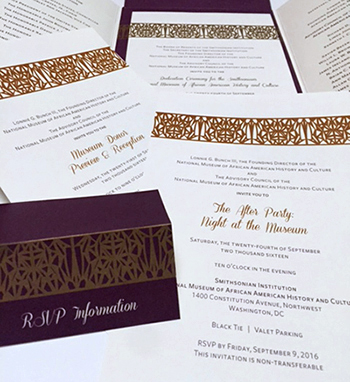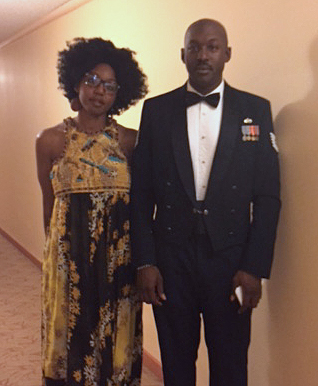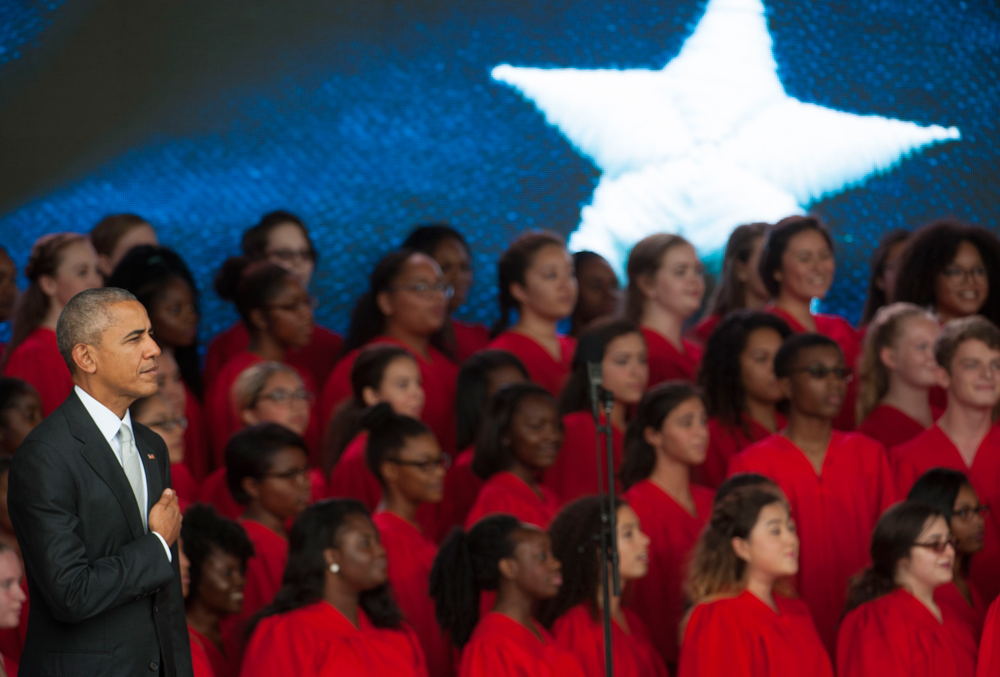On September 24th, 2016, millions of people all over the country celebrated the opening of a long-awaited addition to the Smithsonian collection of national museums in Washington, D.C. More than 30,000 people visited the National Museum of African American History and Culture during the opening weekend. Among them were AIGA DC members, who have generously shared with us their impressions, thoughts, and reflections, which we are proud to share with you in a series of posts over the next few weeks.
Dian Holton, a Deputy Art Director at AARP and a long-time AIGA DC Board member, has been actively involved in making the NMAAHC a reality for years leading up to the big day. Here is her story.
AIGA DC: You are an NMAAHC “ambassador.” What does this mean? How did you get involved?
Dian Holton: The museum planning had been in the making for a very long time. However, it didn’t register with me until years after I moved to the DMV. I can’t recall the exact day, but I do remember meeting someone from the museum who was pitching the benefits of being an ambassador of a yet unseen museum. They were fundraising aggressively, and especially among young black professionals who had some money to spend.

The invitation to the Night at the Museum event at NMAAHC. (photo courtesy of Dian Holton)
During their soft pitch, I thought about all the money I’d blown on trips (albeit many were awesome), I knew that I’d spent a lot of money in the past on senseless things that left no lasting impression, let alone memories. I did the math and realized that my monthly donation would help fund the building of an institution that would help foster education and insight related to my ancestry, my present, my legacy. That night, I signed up and made the first of ongoing donations. It’s been several years now, and I still tout that I’m an ambassador. Not only because I’m still honoring my pledge commitment, but because the museum, designed by David Adjaye, is open and it is beautiful.
As a thank-you for our continuing support, museum ambassadors were gifted with tickets to screenings, showcases, panel discussions, collections previews, pre-opening previews, and the ultimate—day of dedication invitation, which came in a eggplant die-cut gatefold along with an entry pass for The Night at the Museum gala.
AIGA DC: The museum opening was a star-studded event. Whom did you bring?
Dian Holton: After a little finagling with schedules, I had the distinct pleasure of sharing this event with two of my favorite people: my mom and my brother, a U.S. Airman stationed in Clovis, New Mexico. Neither could be more ecstatic. I wish my dad could have attended, but he had previous obligations, which also included watching his precious Yorkie and my mom’s inherited Bichon mix.
While I won’t go into lengthy detail about the emotions that resonated with my mom—a South Georgia single child who lived through poignant moments in history—I will say that she beat me into the space and made fast friends with attendees that included retired generals and their daughters. It was clear during that visit that many, whether wheelchair-bound or confidently walking through, were having real moments of reflection on where we’ve been and where we as a people are going.

Dian Holton and her brother Will. (photo courtesy of Dian Holton)
My little big brother, on the other hand, had been warned. I made sure to tell him to hydrate and be alert. To wear comfortable shoes and be mindful of the people who were coming from near and far like him to witness this moment in time. It was his birthday, and what better gift than to give your sibling this opportunity? It’s not every day a Smithsonian opens. Big Will, as we like to call him, stood with me in the well-dressed security line for what appeared to be hours.
Once on site, we watched as dignitaries and celebrities shared words of hope, trials and tribulations related to the African American experience. From Rep. John Lewis to Presidents Obama and Bush, Oprah, Will Smith, Dr. Shirley Ann Jackson and the Reverend Calvin O. Butts, the speeches were powerful and meaningful. Every now and then I thought Big Will wasn’t listening, but then he would surprise me and say something poignant about the speech delivered. At one point, he even sung along with Patti LaBelle when she belted out Sam Cooke’s “A Change Is Gonna Come.” I didn’t realize he even knew who that was.

Patti LaBelle sings at the NMAAHC dedication. (photo courtesy of NMAAHC / Benjamin G. Sullivan)
AIGA DC: The photos and videos of President Obama and the First Lady at the dedication ceremony were widely shared in the news and social media. How was it to see him speak?
Dian Holton: President Obama eloquently delivered a speech in that oh-too-familiar cadence on the significance of this museum. We listened intently, as he reaffirmed to everyone that we too are Americans and history, while it might make us uncomfortable at times, is when we learn and grow. He touched on “suffering and delight, fear and hope” and how protests and love of country don’t merely coexist but inform each other.
Obama was clear and current. He didn’t stutter when he stated that “you can wear an ‘I can’t breathe’ T-shirt and still grieve for fallen police officers.” He didn’t mince words when he concluded that American history was “complicated and messy and full of contradictions as all great stories are.” He did admit that a museum couldn’t solve all of our problems—eliminate gun violence, ensure that justice is colorblind or prevent discrimination. He reminded us that it falls on us to speak out, organize, and vote until our values are fully reflected in our laws, policies and communities.

The Voices of Tomorrow choir is drawn from several high schools and performing arts schools in the D.C. area. (photo courtesy of NMAAHC / Leah L. Jones)
The museum, in his opinion, shows that America has moved forward. It provides context for the debates of our times, illuminates and gives a sense of how we’ve evolved, and, fingers crossed, will educate visitors (no matter their race) on significant issues within and affecting the African American community. He hoped that through institutions like this, we Americans will be better at talking, listening and seeing each other. That we’d be better at grasping the truth.
AIGA DC: Could you tell us about the Night at the Museum Gala?
Dian Holton: The gala wasn’t as long as the movie it was named after, and none of the artifacts came alive—though if they had, there would’ve been some very interesting and fiery conversations.
Upon arrival, we were greeted by a live gospel choir performance outside. Swaying and moving, the songbirds sung in unison. My brother and I took our time making our way inside the building—trying to soak up every moment of this experience. Too tired to indulge on the endless amount of food and drinks catered that evening, I’d explained again to him the reality of seeing the entire museum but just to take in what he could. The museum, which is five floors, cannot be consumed in two or even three hours. As much as you may try, it is, after all, a Smithsonian. A library of life and death. It would take a person at least a week to comprehend the entirety of it. So, I would have joined him in the exploration, but then I caught a glimpse of comedian Dave Chappelle behind me heading to the stage and I realized … I wasn’t going anywhere.
I stayed and listened to Chappelle and his friends, singers En Vogue and jazz musician Robert Glasper. Big Will, dressed in his Air Force blues, explored the space. He attempted to take in two or three floors, which included Nat Turner’s Bible, the Jim Crow-era railroad car, and the slave cabin from Edisto Island. When I peeled away, I headed up the escalators to find DC’s BK Adams Blue Horse and other artwork by friends that occupied floors I hadn’t viewed.
AIGA DC: What were your thoughts once you’ve had a chance to reflect on this historic occasion?
Dian Holton: After a few hours, my brother and I headed to my house to reconnect with our mother. We agreed that this moment was monumental and invaluable. That it’s going to be a while before any of us would have the opportunity to view the museum again and certainly not in the way we did on that day. We are grateful for all that came before us and paved the way for us (being you, me, our neighbors, our communities) to exist. We only hope that we can continue to forge ahead and improve on that legacy. Creating a future of goodwill, empowerment, education, unity, gratitude and honor for the next generation.
In the words of NMAAHC’s Director Lonnie Bunch, “As long as that there is an America, this museum will educate, engage and ensure a fuller story of our country will be told on the national mall.”
. . .
Watch the dedication here, and be sure to read more posts in this series:
“A Museum for All: AIGA DC Members on the Historic Importance of the National Museum of African American History and Culture.”
“Honor the Past by Being Present: the National Museum of African American History and Culture Opening Dedication”
(Lead photo courtesy of NMAAHC / Alan Karchmer)